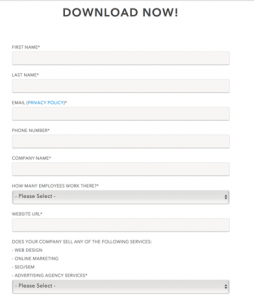 For many businesses, one of the frustrating things about content marketing is feeling like you’re investing a lot of time and money, putting a lot of value out into the world – but it’s hard to connect that work back to solid leads and sales. One of the tools content marketers have to bridge that gap and turn content into a more direct lead generation tool is gated content.
For many businesses, one of the frustrating things about content marketing is feeling like you’re investing a lot of time and money, putting a lot of value out into the world – but it’s hard to connect that work back to solid leads and sales. One of the tools content marketers have to bridge that gap and turn content into a more direct lead generation tool is gated content.
But while putting content behind a form means you gain something (leads and information), you also lose something. If you’re going to use gated content, you have to think carefully about why and how.
What is Gated Content?
Gated content is any content that’s only accessible to people that provide something in exchange for viewing it. In most marketing cases, that means personal information like a name and email address or business information like your title and business size. Sometimes it can also mean content that goes behind a paywall, so you can only see it after paying for it, but that’s more common for media publications than marketing uses.


4 Reasons to Gate Content
Gated content gives you a way to get something back for the content you put so much work into. There are a few good reasons to consider gating your content:
- To gain leads
When a person hands over information about themselves to download your content, you end up with more knowledge about a potential future customer. You know what topic they’re interested in (based on what they downloaded) and how to get back in touch with them. That’s information you can do something with if they look like a promising lead.
- To collect more information from your leads
A name and an email address can be enough to count someone as a lead, but the more you know about them the more you’re able to be targeted in your contact with them. Sometimes the form for a piece of gated content includes additional fields like business size and industry. And if someone that’s already a lead comes back to check out more of your gated content, you can ask for different information than you did the first time – you already have their email, but maybe they can tell you now the services they offer or their biggest business challenge.
- It gives you an in to continue the relationship
Someone who views a blog post may find it valuable, but then leave the website and never return. When someone gives you contact information they’re showing engagement and giving you a way to keep the relationship going – something that can often be hard to pull off in content marketing.
- It signals higher-value content
While content marketing is often all about providing value to your audience (for free), there’s definitely still a sense in our culture that a thing too easily gotten can’t be worth as much. For someone with that mentality, a piece of content they have to give something up for will immediately look more valuable than something publicly available to everyone. Putting content behind a form can therefore be a way of communicating that there’s something special about this piece of content, which can make it look more enticing to your audience.
5 Reasons Not to Gate Content
I’m going to come right out with a clear stance here: not all content should be gated. The benefits of leaving content publicly available on your website are too significant to gate everything.
- Gated content creates friction.
Anytime you put a barrier between people and what you want them to see, you’re decreasing the number of people that will take that step. In some contexts, that’s ok. Having fewer relevant leads is better than lots of irrelevant ones. But a big part of marketing is creating awareness of your brand and product, and content has an important role to play in that. It won’t help people learn you exist if they can’t see any of the content you create because it’s hidden behind a form.
- It can cause annoyance.
If someone doesn’t know enough about your brand to trust you and care about what you have to say, being hit with a form first thing asking them to hand over their information is obnoxious. Not only will they probably not provide the information you’ve asked for, but their overall experience on your website will be negative.
If you overuse gated content without taking the time to build up trust with freely accessible content, then you can expect your visitors to experience annoyance and frustration – clearly not emotions you want to cause in potential customers.
- You lose out on SEO value.
When you put your content out of reach for prospects, you’re putting it out of reach for Google’s algorithms as well. Why would they want to rank a page that has partial information on it with a form to learn more rather than a page on the same subject that lays out all the information a searcher would need? If SEO is a priority (and it should be for most businesses doing content marketing), then most of your content should remain ungated.
- You lose out on links.
This is related to SEO, but worth mentioning on its own. When a writer is looking for content to link to in a post or article that will add value to their readers, they’re less likely to choose a resource that their readers won’t find readily accessible. With some exceptions where what’s behind the gate is so uniquely valuable as to be worth it (original research being the main one), they’ll skip over your gated content and find a resource that’s not behind a form to use.
- Your blog can be a tool to gain leads without gated content.
If your blog content is consistently useful and you promote your email list throughout the blog and website, then you can gain email signups and leads without putting your content behind a gate. Sticking your best stuff behind a form isn’t the only way to gain leads.
What’s Right For You?
Whether or not you should gate your content depends on three main things:
- Your goals
- Your audience
- Whether or not you have content worth gating
If the main goals of your content marketing program are awareness and SEO, then gated content probably isn’t for you. But if it’s crucial to you to gain leads with your content and your blog isn’t doing the trick, then working up some especially high-quality resources to put behind a form could be a great idea. It all depends on your overall goals and if gating makes sense within the rest of your content strategy.
If You Use Gated Content
If you do decide to start using gated content, then it’s important to do so in a way that keeps your audience top of mind and helps you meet your goals.
Make sure your content is worth it.
First things first, if you put lackluster content behind a gate, people will resent you for it. And if you reach out to contact them after, you’re doing so at a disadvantage because they already lost their trust in you. So you have to make sure any gated content you create is top of the line.
Ask yourself:
- Do I know this is a topic my audience cares about?
- Is there anything in my gated content people couldn’t easily find with a simple Google search?
- Will my audience walk away from this content having learned something they can use to make their lives or work better?
If you can’t confidently answer all three of those questions with a “yes,” this content shouldn’t go behind a form.
Don’t ask for too much.
There are definitely people who would be willing to download content that only asks for an email address, but will balk if you ask for their email, title, business size, industry, date of birth, name of their firstborn…you get the idea. The more time it takes someone to fill out the form and the more they feel like they have to give up, the harder you’re making it for them to say “yes” and complete the task to reach your content.
Think about starting small – just ask for a little information the first time a prospect encounters your gated content. If they come back for more later (a different piece of gated content, that is), you can ask for more.
Promote it like a product.
If you’re putting the time in to create content that’s of a high enough value to put behind a form, then you should commit time to getting it in front of people. Promote your gated content on social media. Plan other relevant content pieces you can use to help promote your gated content and work CTAs into them. Consider pitching relevant guest posts to other blogs that will include links to your gated content, to help get it in front of a new audience. You might even consider paid promotion if you want to make sure you get that much more out of it.
If you simply create it and sit around hoping people will notice and care, you’ll have done all that work for nothing. Help people find the content you worked so hard on.
A/B test forms and CTAs.
If you’d really like to ask for extra information in your form, but aren’t sure you can get away with it without losing leads, do some testing. Figure out different wording to put on the landing page, different fields to include on the form, and different language and designs for the CTAs you use to direct people to your gated content. It’s hard to predict what people will respond to and what wording or design elements will make a difference. You won’t know for sure what matters most unless you test it out.
Make sure you follow up with relevant messaging.
Once a person takes the step of providing their information to download your content, you have an opportunity to keep the relationship going. Don’t bombard them with email marketing, but do work up some follow-up emails that are relevant to the content they downloaded. Use those emails to see about getting them to sign up for your email list or urge them to take further action, like starting a trial or checking out relevant product pages.
Someone who goes so far as to provide you information in order to access your content is usually going to be a valuable lead, so figure out the best strategy for nurturing those leads once you have them.
Gated content may not be right for every brand, and no brand should make it 100% of their content strategy. But if you do decide it’s right for you, it may be a good way to bring in new, relevant leads that are likely to turn into customers. You just have to make sure you do it right.